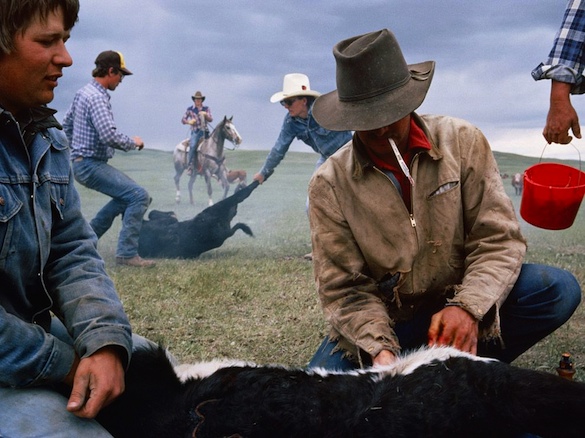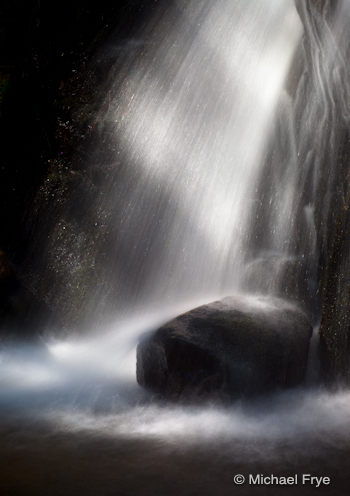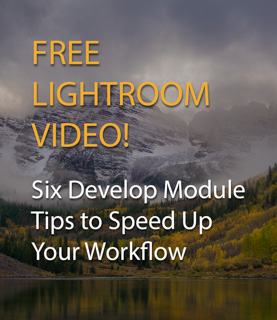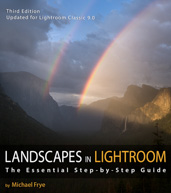Vision and Creativity
by Michael Frye | Aug 29, 2012 | Composition, Photography Tips, Vision and Creativity

(A) Clouds and reflections, Tenaya Lake, Yosemite
At Tenaya Lake last week my workshop student and I watched and photographed a spectacular, constantly-changing cloud display for over two hours. I made many images, including the one at the top of this post (you can see two more here and here). With the lake in the foreground every composition included a prominent horizon line, so I was often thinking about where to place the horizon in the frame.
It’s not always an easy decision. If you’ve ever read any books on composition you probably learned about the rule of thirds. And when applied to horizons this means you should place the horizon a third of the way from the top or bottom of the photograph. And you probably also read that you should, at all costs, avoid putting the horizon in the center of the frame.
As many of you already know, I’m not a big fan of the rule of thirds. It’s too restrictive, too limiting when applied to the infinite number of possible subjects and situations a photographer can encounter. It’s useful sometimes, but shouldn’t be taken as dogma.
I think this applies to horizons as well. Sometimes putting the horizon a third of the way from the top or bottom works. Sometimes it’s better to ignore the rule and put the horizon right in the middle, or near the top or bottom of the frame.
(more…)
by Michael Frye | Aug 16, 2012 | Vision and Creativity

Reeds and Cloud Reflections no. 1
Planning
The future is uncertain, so we try to control it by planning. We think that if we do A and B the result will be C. But sometimes there are too many variables that we can’t account for, so the result might not be C—it could be D, or E, or even Z.
Photographers often try to plan. We imagine that if we go to a certain location at a certain time we’ll capture a certain photograph. Sometimes this works, but frequently the weather doesn’t cooperate or conditions aren’t right.
(more…)
by Michael Frye | Jun 26, 2012 | Vision and Creativity, Workshops

Bristlecone pine snag at night with star trails, White Mountains
Night photography offers wonderful opportunities to be creative. The low light allows you to use long exposures to record movement, like star trails or moonlit clouds. And since the natural light is so dim, you can easily overpower it with a flash or flashlight and add your own light to a scene.
That aspect of night photography—light-painting—has intrigued me for a long time. Adding your own light to a nighttime scene gives it a new dimension; it instantly transforms the landscape into something different, something we never see in real life, and adds a mysterious, surreal element to the photograph.
The accompanying image has both movement, in the form of star trails, and light-painting. I used a flashlight to trace the branches of this bristlecone pine snag, then painted zig-zag lines over the rocky foreground. I made this photograph with medium-format film back in September of 2000. Some test exposures with a Polaroid back helped me get the light-painting right, then I switched to real film (probably Provia), did the light-painting again, and then left the shutter open for another 90 minutes to record the star trails. You can see more examples of my light-painting techniques in my nighttime portfolio.
I learned light-painting with film, which was a slow trial-and-error (mostly error) process. Digital cameras make the learning curve much easier, because you can experiment and see the results immediately. If you’ve never tried night photography before this might be a fun summertime project—a way to stretch yourself a little and exercise your imagination. Summer is a great season for photographing landscapes at night, since the Milky Way is prominent, and the warm nighttime temperatures make it more comfortable to stay out late.
Whether you’re an experienced night photographer or a beginner, I recommend reading Lance Keimig and Scott Martin’s excellent book Night Photography: Finding Your Way in the Dark. Also, you can find tips about focus and exposure for moonlit landscapes in my post about photographing lunar rainbows.
And if you prefer hands-on learning there’s still space in my Full Moon Night Photography workshop later this summer (July 31st and August 1st). This is a great way to get personalized instruction and learn night photography in a fun, supportive group atmosphere. Rooms have been set aside for this workshop in Yosemite Valley and are still available if you register soon.
—Michael Frye
Related Posts: Under the Full Moon; Tips for Photographing Lunar Rainbows; Also, see images made by participants in last year’s night photography workshop in this Flickr group
Michael Frye is a professional photographer specializing in landscapes and nature. He is the author and photographer of The Photographer’s Guide to Yosemite, Yosemite Meditations, and Digital Landscape Photography: In the Footsteps of Ansel Adams and the Great Masters, plus the eBooks Light & Land: Landscapes in the Digital Darkroom, and Exposure for Outdoor Photography. He has written numerous magazine articles on the art and technique of photography, and his images have been published in over thirty countries around the world. Michael has lived either in or near Yosemite National Park since 1983, currently residing just outside the park in Mariposa, California.
by Michael Frye | Jun 20, 2012 | Vision and Creativity

Sam Abell’s classic image of cowboys castrating cattle in Montana
It’s not often that you get to hear a master photographer explain how he made one of his greatest images, so I was thrilled to find this short video of Sam Abell describing how he made his classic photograph of cowboys branding cattle in Montana.
I love this statement: “What we’re all trying to do is make a layered, deep, complex, complicated photograph that doesn’t look complex or complicated.”
In talking about composition in my workshops and books I emphasize simplicity, since I think the single most common mistake people make is including too much in the frame. But my favorite images are rich and complex, without crossing the line into being busy and confusing. Obviously it takes years of experience to be able to make photographs like that – and Abell’s experience and mastery are on full display in this image.
(more…)
by Michael Frye | Mar 9, 2012 | Photography Tips, Vision and Creativity

Small waterfall in Yosemite Valley, high noon
Everyone develops routines and habits: waking up at the same time every day, eating the same thing for breakfast, taking the same route to work… and on and on. Routines are beneficial in some ways—they help us avoid spending time and energy making small, unimportant decisions every day.
In photography, routines can help with the technical, left-brained stuff. Always putting lens caps in the same place in your camera bag, or the same pants pocket, can help save time and avoid frustration. Checking off a mental list before pressing the shutter can prevent mistakes. Did you adjust the polarizer? Focus? Set the right aperture? Shutter speed? Did you check the histogram? What’s your ISO?
But routines also dull the senses, and in photography that can be deadly. I’ve photographed this small waterfall in Yosemite many times, but always in the shade. Soft light works well for subjects like this—it makes it easy to use slow shutter speeds, and simplifies the lighting. So I’d never even considered visiting this spot when sunlight was hitting the water.
Last weekend I was shooting footage for some instructional videos in Yosemite Valley. I wanted to talk about using slow shutter speeds with moving water, but the crew only had one day in Yosemite, and the schedule only allowed us to visit this waterfall at noon. As we approached the fall I thought, hmm, this might work. Backlight filtering through the trees created some interesting patterns, and as the sun moved it started to highlight just the right spots. As I was demonstrating how different shutter speeds affected the appearance of the water, I was looking at the images on my viewfinder and thinking, “Wow, that looks pretty cool!”
(more…)
by Michael Frye | Jul 12, 2011 | Composition, Photography Tips, Vision and Creativity

Redwoods and rhododendrons—telephoto view
A Tale of Two Photographs
Reading David duChemin’s eBook A Deeper Frame got me thinking about how we perceive depth and space in photographs, and how lens choice affects that perception.
David says that because photography turns “a world of three dimensions into two,” that “if we aim to create photographs that create within the reader a deeper, fuller, longer experience, it falls to us to recreate that depth.”
There’s no question that wide-angle lenses are better tools for creating a sense of depth in a photograph than telephoto lenses. Telephotos make objects appear closer together than they really are, compressing space and flattening the perspective. Wide-angle lenses make objects appear farther apart than they really are, expanding the sense of space, and, if used correctly, creating an illusion of depth.
These two photographs from my recent trip to the redwoods illustrate the difference. Both images include the same rhododendrons and redwoods.
In the top image I stepped back with a telephoto lens (130mm) and isolated part of the bush against two redwood trunks. It looks like the rhododendrons are only a few feet in front of the trees, but they’re not. They’re at least 20 feet away—illustrating the compression effect of the telephoto lens. The sense of depth is minimal.
(more…)














